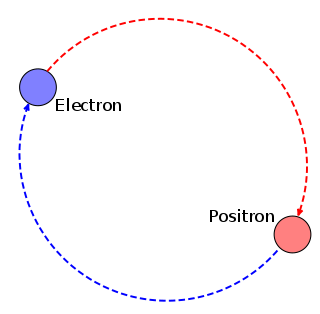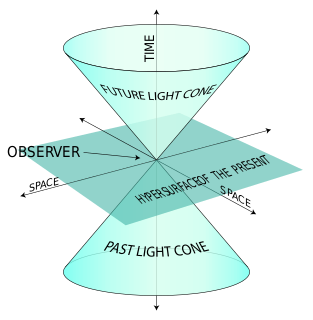Related Research Articles

A gluon is an elementary particle that acts as the exchange particle for the strong force between quarks. It is analogous to the exchange of photons in the electromagnetic force between two charged particles. Gluons bind quarks together, forming hadrons such as protons and neutrons.

Positronium (Ps) is a system consisting of an electron and its anti-particle, a positron, bound together into an exotic atom, specifically an onium. The system is unstable: the two particles annihilate each other to predominantly produce two or three gamma-rays, depending on the relative spin states. The energy levels of the two particles are similar to that of the hydrogen atom. However, because of the reduced mass, the frequencies of the spectral lines are less than half of those for the corresponding hydrogen lines.
String field theory (SFT) is a formalism in string theory in which the dynamics of relativistic strings is reformulated in the language of quantum field theory. This is accomplished at the level of perturbation theory by finding a collection of vertices for joining and splitting strings, as well as string propagators, that give a Feynman diagram-like expansion for string scattering amplitudes. In most string field theories, this expansion is encoded by a classical action found by second-quantizing the free string and adding interaction terms. As is usually the case in second quantization, a classical field configuration of the second-quantized theory is given by a wave function in the original theory. In the case of string field theory, this implies that a classical configuration, usually called the string field, is given by an element of the free string Fock space.
In theoretical physics, the term renormalization group (RG) refers to a formal apparatus that allows systematic investigation of the changes of a physical system as viewed at different scales. In particle physics, it reflects the changes in the underlying force laws as the energy scale at which physical processes occur varies, energy/momentum and resolution distance scales being effectively conjugate under the uncertainty principle.
In particle physics, asymptotic freedom is a property of some gauge theories that causes interactions between particles to become asymptotically weaker as the energy scale increases and the corresponding length scale decreases.
In physics, the Landau pole is the momentum scale at which the coupling constant of a quantum field theory becomes infinite. Such a possibility was pointed out by the physicist Lev Landau and his colleagues. The fact that couplings depend on the momentum scale is the central idea behind the renormalization group.

In quantum field theory, the quantum vacuum state is the quantum state with the lowest possible energy. Generally, it contains no physical particles. The word zero-point field is sometimes used as a synonym for the vacuum state of a quantized field which is completely individual.
Mark Brian Wise is a Canadian-American theoretical physicist. He has conducted research in elementary particle physics and cosmology. He is best known for his role in the development of heavy quark effective theory (HQET), a mathematical formalism that has allowed physicists to make predictions about otherwise intractable problems in the theory of the strong nuclear interactions. He has also published work on mathematical models for finance and risk assessment.

Two-photon physics, also called gamma–gamma physics, is a branch of particle physics that describes the interactions between two photons. Normally, beams of light pass through each other unperturbed. Inside an optical material, and if the intensity of the beams is high enough, the beams may affect each other through a variety of non-linear effects. In pure vacuum, some weak scattering of light by light exists as well. Also, above some threshold of this center-of-mass energy of the system of the two photons, matter can be created.

In particle physics, the history of quantum field theory starts with its creation by Paul Dirac, when he attempted to quantize the electromagnetic field in the late 1920s. Heisenberg was awarded the 1932 Nobel Prize in Physics "for the creation of quantum mechanics". Major advances in the theory were made in the 1940s and 1950s, leading to the introduction of renormalized quantum electrodynamics (QED). QED was so successful and accurately predictive that efforts were made to apply the same basic concepts for the other forces of nature. By the late 1970s, these efforts successfully utilized gauge theory in the strong nuclear force and weak nuclear force, producing the modern standard model of particle physics.
The Scharnhorst effect is a hypothetical phenomenon in which light signals travel slightly faster than c between two closely spaced conducting plates. It was first predicted in a 1990 paper by Klaus Scharnhorst of the Humboldt University of Berlin, Germany. He showed using quantum electrodynamics that the effective refractive index n, at low frequencies, in the space between the plates was less than 1. Barton and Scharnhorst in 1993 claimed that either signal velocity can exceed c or that imaginary part of n is negative.
Montonen–Olive duality or electric–magnetic duality is the oldest known example of strong–weak duality or S-duality according to current terminology. It generalizes the electro-magnetic symmetry of Maxwell's equations by stating that magnetic monopoles, which are usually viewed as emergent quasiparticles that are "composite", can in fact be viewed as "elementary" quantized particles with electrons playing the reverse role of "composite" topological solitons; the viewpoints are equivalent and the situation dependent on the duality. It was later proven to hold true when dealing with a N = 4 supersymmetric Yang–Mills theory. It is named after Finnish physicist Claus Montonen and British physicist David Olive after they proposed the idea in their academic paper Magnetic monopoles as gauge particles? where they state:
There should be two "dual equivalent" field formulations of the same theory in which electric (Noether) and magnetic (topological) quantum numbers exchange roles.
In physics, a renormalon is a particular source of divergence seen in perturbative approximations to quantum field theories (QFT). When a formally divergent series in a QFT is summed using Borel summation, the associated Borel transform of the series can have singularities as a function of the complex transform parameter. The renormalon is a possible type of singularity arising in this complex Borel plane, and is a counterpart of an instanton singularity. Associated with such singularities, renormalon contributions are discussed in the context of quantum chromodynamics (QCD) and usually have the power-like form as functions of the momentum . They are cited against the usual logarithmic effects like .
Delbrück scattering, the deflection of high-energy photons in the Coulomb field of nuclei as a consequence of vacuum polarization, was observed in 1975. The related process of the scattering of light by light, also a consequence of vacuum polarization, was not observed until 1998. In both cases, it is a process described by quantum electrodynamics.

An onium is a bound state of a particle and its antiparticle. These states are usually named by adding the suffix -onium to the name of one of the constituent particles, with one exception for "muonium"; a muon–antimuon bound pair is called "true muonium" to avoid confusion with old nomenclature.
In theoretical physics, the Born–Infeld model is a particular example of what is usually known as a nonlinear electrodynamics. It was historically introduced in the 1930s to remove the divergence of the electron's self-energy in classical electrodynamics by introducing an upper bound of the electric field at the origin.

The light-front quantization of quantum field theories provides a useful alternative to ordinary equal-time quantization. In particular, it can lead to a relativistic description of bound systems in terms of quantum-mechanical wave functions. The quantization is based on the choice of light-front coordinates, where plays the role of time and the corresponding spatial coordinate is . Here, is the ordinary time, is one Cartesian coordinate, and is the speed of light. The other two Cartesian coordinates, and , are untouched and often called transverse or perpendicular, denoted by symbols of the type . The choice of the frame of reference where the time and -axis are defined can be left unspecified in an exactly soluble relativistic theory, but in practical calculations some choices may be more suitable than others.
Thomas Carlos Mehen is an American physicist. His research has consisted of primarily Quantum chromodynamics (QCD) and the application of effective field theory to problems in hadronic physics. He has also worked on effective field theory for non-relativistic particles whose short range interactions are characterized by a large scattering length, as well as novel field theories which arise from unusual limits of string theory.

Augusto Sagnotti is an Italian theoretical physicist at Scuola Normale.
In quantum chromodynamics, heavy quark effective theory (HQET) is an effective field theory describing the physics of heavy quarks. It is used in studying the properties of hadrons containing a single charm or bottom quark. The effective theory was formalised in 1990 by Howard Georgi, Estia Eichten and Christopher Hill, building upon the works of Nathan Isgur and Mark Wise, Voloshin and Shifman, and others.
References
- Caswell, W.E.; Lepage, G.P. (1986). "Effective lagrangians for bound state problems in QED, QCD, and other field theories". Physics Letters B. Elsevier BV. 167 (4): 437–442. Bibcode:1986PhLB..167..437C. doi:10.1016/0370-2693(86)91297-9. ISSN 0370-2693.
- Labelle, Patrick (1992). "Nrqed in Bound States: Applying Renormalization to an Effective Field Theory". arXiv: hep-ph/9209266 . Bibcode:1992hep.ph....9266L.
{{cite journal}}: Cite journal requires|journal=(help)